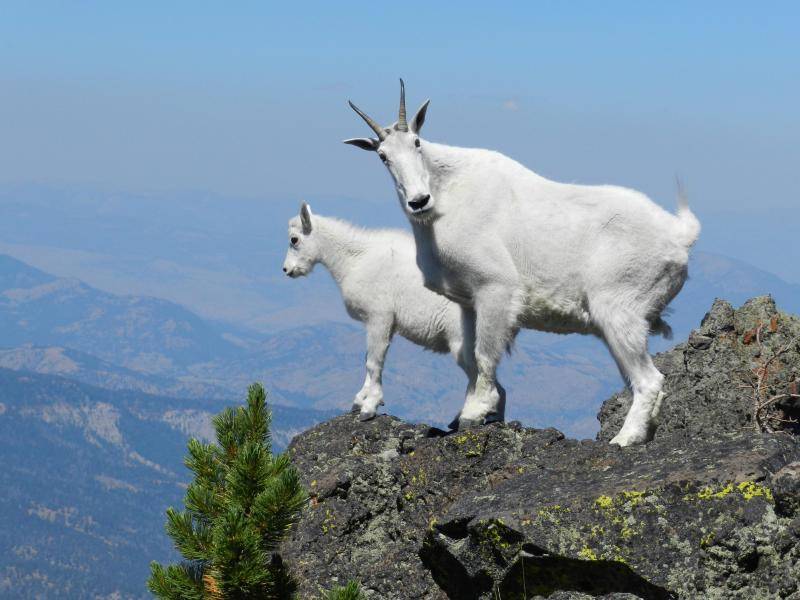Mountain goats are found throughout the Kenai Mountains, including lands managed by the Kenai National Wildlife Refuge. While mountain goats have been introduced to Kodiak Island, the Kenai Mountains represent the westernmost extent of the species’ natural range in North America. Mountain goats occur at their highest densities in coastal areas, but they also occur at lower densities throughout the interior Kenai Mountains. Although mountain goats are primarily managed for sport and subsistence hunting, they are also important for recreational viewing and photography, and to sustain the structure and function of alpine habitats.
When the first western trappers and miners reached the Kenai Peninsula, they hunted mountain goats for their meat and valuable hides. Of course, Alaska Native communities had been hunting goats in the area for centuries. The steep rocky terrain that mountain goats use to avoid predators makes them relatively difficult to harvest with traditional weapons and early records suggest that Alaska Native communities probably coexisted well with goats in the Kenai Mountains. The advent of modern firearms, however, changed the game as hunters became increasingly efficient at harvesting goats at greater distances.
Prior to 1971, mountain goat harvests in the Kenai Mountains were essentially unrestricted. Harvests during the 1950s and 1960s resulted in significant declines in many mountain goat populations. As relatively high harvests continued throughout the 1970s, Kenai goat populations declined by 25% or more. Much of the following was pulled from an excellent article by Thomas McDonough and Jeff Selinger, local biologists with the Alaska Department of Fish & Game.
In some areas, like Cecil Rhode Mountain near Cooper Landing, overharvests even resulted in localized extirpation. Reintroductions during the early 1980s, coupled with natural recolonization from nearby areas and limited local harvests, helped reestablish the population of mountain goats that we see there today.
During the early 1970s, depletion of mountain goat populations became increasingly apparent and harvest limits were reduced to one goat per year. The total number of hunters afield, however, was not limited and goat populations continued to decline under high harvest pressure, particularly in easily accessible areas.
During the 1980s, ADF&G established distinct hunt units to more evenly distribute hunting pressure and protect easily accessible populations from overharvest. Limited entry draw-permit and registration hunts were also established which reduced the number of mountain goats being harvested within specific areas.
These improved management practices during the 1980s and early 1990s helped mountain goat populations rebound throughout much of the Kenai Mountains. Minimum count data show that mountain goats began to increase during the mid-1970s, finally reaching a peak during the early 1990s.
Populations declined for unknown reasons during the late 1990s and early 2000s, but many populations appear to have stabilized since 2005. Some survey units have also shown positive trends in goat numbers, and data from minimum count surveys suggest that some populations in several areas have increased in recent years. These minimum count data, which provide biologists with information on population trends within survey units, generally show an overall increase in mountain goat abundance during 2005–2014.
Increased efforts by the ADF&G to educate hunters on how to differentiate billies from nannies may also have helped reduce the number of reproductive-aged females being harvested each year. As has been seen in the Kenai Mountains and elsewhere in Alaska, harvests of reproductive-aged females can result in significant population declines and even extirpation of local populations. Because native mountain goat populations generally exhibit low reproductive rates, harvests of even just a few adult females can have substantial negative effects on population performance, which can ultimately reduce future hunting opportunities for all users.
But hunting isn’t the only factor effecting mountain goat population performance. Climatic conditions, such as severe winters, persistent snow conditions, and icing events can also be important limiting factors that can affect goats in the Kenai Mountains. The role of our rapidly warming climate in mountain goat population dynamics in the Kenai Mountains is an important aspect of their ecology that warrants further investigation. As with wild sheep, diseases and parasites may also play an important role in population dynamics, but relatively little is known about how these factors effect populations.
For a more detailed history of mountain goat populations in the Kenai Mountains, I encourage you to read the original article that was published in the Proceedings of the 16th Biennial Symposium of the Northern Wild Sheep and Goat Council (http://media.nwsgc.org/proceedings/NWSGC-2008/NWSGC_2008.pdf).
Later this summer, biologists from ADF&G, Kenai Refuge, Chugach National Forest and the National Park Service are planning to conduct the first complete estimate of mountain goat populations on the Kenai Peninsula since the 1960s. Stay tuned!
Dominique Watts is a wildlife biologist at Kenai National Wildlife Refuge. Find more information about the refuge at http://kenai.fws.gov or http://www.facebook.com/kenainationalwildliferefuge.


